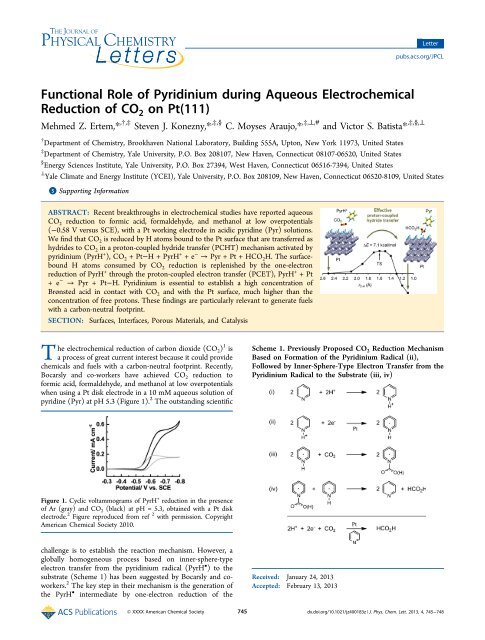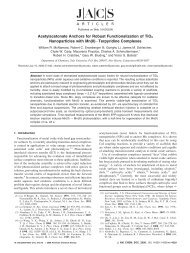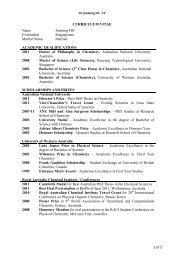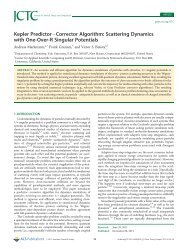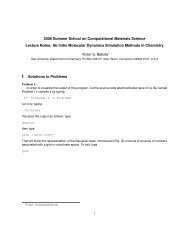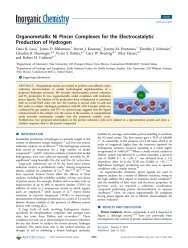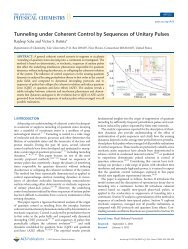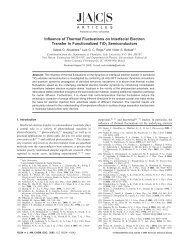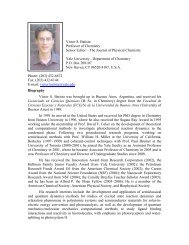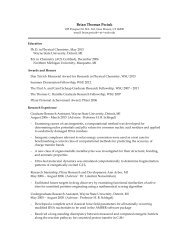J. Phys. Chem. Lett. 4, 745-748 - Yale Chemistry - Yale University
J. Phys. Chem. Lett. 4, 745-748 - Yale Chemistry - Yale University
J. Phys. Chem. Lett. 4, 745-748 - Yale Chemistry - Yale University
Create successful ePaper yourself
Turn your PDF publications into a flip-book with our unique Google optimized e-Paper software.
<strong>Lett</strong>er<br />
pubs.acs.org/JPCL<br />
Functional Role of Pyridinium during Aqueous Electrochemical<br />
Reduction of CO 2 on Pt(111)<br />
Mehmed Z. Ertem,* ,†,‡ Steven J. Konezny,* ,‡,§ C. Moyses Araujo,* ,‡,⊥,# and Victor S. Batista* ,‡,§,⊥<br />
† Department of <strong>Chem</strong>istry, Brookhaven National Laboratory, Building 555A, Upton, New York 11973, United States<br />
‡ Department of <strong>Chem</strong>istry, <strong>Yale</strong> <strong>University</strong>, P.O. Box 208107, New Haven, Connecticut 08107-06520, United States<br />
§ Energy Sciences Institute, <strong>Yale</strong> <strong>University</strong>, P.O. Box 27394, West Haven, Connecticut 06516-7394, United States<br />
⊥ <strong>Yale</strong> Climate and Energy Institute (YCEI), <strong>Yale</strong> <strong>University</strong>, P.O. Box 208109, New Haven, Connecticut 06520-8109, United States<br />
*S Supporting Information<br />
ABSTRACT: Recent breakthroughs in electrochemical studies have reported aqueous<br />
CO 2 reduction to formic acid, formaldehyde, and methanol at low overpotentials<br />
(−0.58 V versus SCE), with a Pt working electrode in acidic pyridine (Pyr) solutions.<br />
We find that CO 2 is reduced by H atoms bound to the Pt surface that are transferred as<br />
hydrides to CO 2 in a proton-coupled hydride transfer (PCHT) mechanism activated by<br />
pyridinium (PyrH + ), CO 2 +Pt−H + PyrH + +e − → Pyr + Pt + HCO 2 H. The surfacebound<br />
H atoms consumed by CO 2 reduction is replenished by the one-electron<br />
reduction of PyrH + through the proton-coupled electron transfer (PCET), PyrH + +Pt<br />
+e − → Pyr + Pt−H. Pyridinium is essential to establish a high concentration of<br />
Brønsted acid in contact with CO 2 and with the Pt surface, much higher than the<br />
concentration of free protons. These findings are particularly relevant to generate fuels<br />
with a carbon-neutral footprint.<br />
SECTION: Surfaces, Interfaces, Porous Materials, and Catalysis<br />
The electrochemical reduction of carbon dioxide (CO 2 ) 1 is<br />
a process of great current interest because it could provide<br />
chemicals and fuels with a carbon-neutral footprint. Recently,<br />
Bocarsly and co-workers have achieved CO 2 reduction to<br />
formic acid, formaldehyde, and methanol at low overpotentials<br />
when using a Pt disk electrode in a 10 mM aqueous solution of<br />
pyridine (Pyr) at pH 5.3 (Figure 1). 2 The outstanding scientific<br />
Scheme 1. Previously Proposed CO 2 Reduction Mechanism<br />
Based on Formation of the Pyridinium Radical (ii),<br />
Followed by Inner-Sphere-Type Electron Transfer from the<br />
Pyridinium Radical to the Substrate (iii, iv)<br />
Figure 1. Cyclic voltammograms of PyrH + reduction in the presence<br />
of Ar (gray) and CO 2 (black) at pH = 5.3, obtained with a Pt disk<br />
electrode. 2 Figure reproduced from ref 2 with permission. Copyright<br />
American <strong>Chem</strong>ical Society 2010.<br />
challenge is to establish the reaction mechanism. However, a<br />
globally homogeneous process based on inner-sphere-type<br />
electron transfer from the pyridinium radical (PyrH • ) to the<br />
substrate (Scheme 1) has been suggested by Bocarsly and coworkers.<br />
2 The key step in their mechanism is the generation of<br />
the PyrH • intermediate by one-electron reduction of the<br />
Received: January 24, 2013<br />
Accepted: February 13, 2013<br />
© XXXX American <strong>Chem</strong>ical Society <strong>745</strong> dx.doi.org/10.1021/jz400183z | J. <strong>Phys</strong>. <strong>Chem</strong>. <strong>Lett</strong>. 2013, 4, <strong>745</strong>−<strong>748</strong>
The Journal of <strong>Phys</strong>ical <strong>Chem</strong>istry <strong>Lett</strong>ers<br />
pyridinium cation (PyrH + ) (Scheme 1, ii). The PyrH • species<br />
then reacts with CO 2 to generate a carbamate intermediate in<br />
the rate-determining step (Scheme 1, iii), a species recently<br />
probed by gas-phase vibrational spectroscopy. 3 Reduction of<br />
the carbamate by another PyrH • produces formic acid (Scheme<br />
1, iv), and further reductions involving the pyridinium radical<br />
form formaldehyde and then methanol.<br />
A density functional theory (DFT) study has ruled out the<br />
possibility of PyrH • generation in the homogeneous phase by<br />
reduction of PyrH + at overpotentials consistent with cyclic<br />
voltammetry (CV) measurements, 4 while a recent theoretical<br />
study has suggested the generation of PyrH • on the surface. 5<br />
Here, we explore whether the Pt surface can assist in the<br />
generation of the PyrH • radical or if instead the reduction of<br />
PyrH + at low overpotentials generates other species that might<br />
be involved in the reduction of CO 2 . A notable feature of the<br />
electrochemical process is the observation of a quasi-reversible<br />
one-electron cathodic wave of CV, corresponding to a<br />
reduction potential of about −600 mV versus SCE (Figure 1,<br />
black line). The sensitivity of the reaction to the nature of the<br />
working electrode shows significant activity for Pt but no<br />
catalytic current for glassy carbon electrodes at such low<br />
overpotentials.<br />
In the present study, we focus on understanding aqueous<br />
CO 2 reduction to formic acid on the Pt(111) surface in the<br />
presence of pyridinium ions. Our free-energy analysis of<br />
reaction intermediates reveals a simple mechanism (Scheme<br />
2). As shown below, an important step of Scheme 2 that bears<br />
Scheme 2. Proposed Mechanism of Electrochemical<br />
Reduction of CO 2 on Pt(111), in an Aqueous Acidic<br />
Pyridine Solution, Based on Our DFT Calculations at the<br />
PBE Level of Theory<br />
<strong>Lett</strong>er<br />
experimental conditions (e.g., 10 mM pyridine (Pyr) solutions<br />
at pH 5.3 have [PyrH + ] = 4.26 mM and [H + ] = 5.0 × 10 −3 mM<br />
because the pK a of PyrH + is 5.17). PyrH + also functions as the<br />
proton donor, with a concentration that is much higher than<br />
the concentration of protons in solution during the PCHT step,<br />
and activates CO 2 during the electrophilic attack by stabilizing<br />
the transition state through hydrogen bonding. 6<br />
Our free-energy analysis of the overall reaction mechanism,<br />
outlined in Scheme 2, is based on the gradient-corrected PBE<br />
level of theory 7 within the plane-wave-based pseudopotential<br />
scheme implemented in the Quantum ESPRESSO software<br />
package. 8 Ultrasoft pseudopotentials were employed for Pt, C,<br />
H, N, and O atoms with plane wave kinetic energy cut off<br />
values of 40 and 480 Ry for the wave functions and the charge<br />
densities, respectively. The Pt(111) surface was modeled by<br />
periodically repeating a 4 × 4 supercell (11.32 Å × 11.32 Å) in<br />
a four-layer slab in which the two bottom layers were fixed at<br />
the optimized bulk lattice constants. The Monkhorst−Pack<br />
type of k-point sampling with 2 × 2 × 1 grid points was used<br />
for periodic slab calculations. The bulk solvation effects were<br />
accounted for through the analysis of cluster models extracted<br />
from the optimized supercells with periodic boundary<br />
conditions, employing the SMD continuum solvation model 9<br />
as implemented in Gaussian09 10 at the PBE level of theory (see<br />
the Supporting Information for more details). Redox potentials<br />
(E 0 = −nFΔG 0 , with F as the Faraday constant and n as the<br />
number of electrons involved in the redox process) were<br />
obtained by computing the half-reaction free-energy change<br />
ΔG 0 = ΔH − TΔS, using the standard Born−Haber<br />
thermodynamic cycle as presented in a recent work. 11<br />
Direct calculations of the reduction potential of PyrH + ,<br />
forming hydrogen atoms adsorbed on the Pt electrode surface<br />
(Scheme 2, ii), are challenging. However, the overall freeenergy<br />
change can be obtained by summing the three freeenergy<br />
changes associated with the thermodynamic cycle of<br />
elementary steps (ii.1−ii.3), described in Scheme 3, including<br />
Scheme 3. Computational Steps (ii.1−ii.3) Used to Obtain<br />
the Free-Energy Change Due to the Overall Reaction (ii)<br />
with PyrH + Reduced to Hydrogen Adsorbed on the Pt<br />
Surface<br />
an electrochemical signature consistent with the observed<br />
quasi-reversible cathodic wave is the pyridinium-facilitated<br />
formation of hydrogen atoms adsorbed on the Pt electrode<br />
surface (Scheme 2, ii). The generated hydrogen adsorbates are<br />
susceptible to electrophilic attack by CO 2 in the presence of<br />
PyrH + (Scheme 2, iii), and they are transferred as hydrides to<br />
the CO 2 substrate in an effective proton-coupled hydride<br />
transfer (PCHT) mechanism.<br />
PyrH + functions as an electrocatalyst that establishes an<br />
effective concentration of Brønsted acid in contact with the Pt<br />
surface that is much higher than the concentration of protons in<br />
solution. Therefore, while hydrogen adsorbates could also<br />
result from reduction of free protons, the pyridinium reduction<br />
by PCET is predominant because the pyridinium concentration<br />
is about 1000 times the proton concentration under typical<br />
desorption of PyrH + from the surface (ii.1), two-electron<br />
reduction to form H 2 (ii.2), and dissociative adsorption of H 2<br />
on the Pt surface. Our results, however, clearly show that the<br />
reaction (ii) proceeds directly as a one-electron reduction<br />
consistent with CV and not through the sequence of steps<br />
(ii.1−ii.3) involving nonspontaneous endothermic desorption<br />
(ii.1) and the two-electron reduction (ii-2).<br />
Free-energy calculations for the elementary steps (ii.1−ii.3)<br />
predict endothermic, nonspontaneous desorption of PyH + from<br />
Pt(111) (Scheme 3, ii.1) with ΔG desorp = 9.9 kcal mol −1 (see<br />
the Supporting Information for more details). The two-electron<br />
aqueous reduction of PyrH + to H 2 and Pyr (Scheme 3, ii.2) is<br />
predicted to require a potential E 0 [PyrH + /H 2 ] = −0.59 V<br />
versus SCE, while the dissociative adsorption of H 2 to the<br />
Pt(111) surface is spontaneous (Scheme 3, ii.3), with ΔG diss =<br />
746<br />
dx.doi.org/10.1021/jz400183z | J. <strong>Phys</strong>. <strong>Chem</strong>. <strong>Lett</strong>. 2013, 4, <strong>745</strong>−<strong>748</strong>
The Journal of <strong>Phys</strong>ical <strong>Chem</strong>istry <strong>Lett</strong>ers<br />
−6.9 kcal mol −1 . The sum of the three steps gives a total freeenergy<br />
change for aqueous reduction of pyridinium to<br />
hydrogen on the Pt surface (Scheme 3, ii) at E 0 = −0.72 V<br />
versus SCE, in good agreement the quasi-reversible reduction<br />
observed by CV (Figure 1). These results suggest that the onset<br />
of the cathodic peak could be the result of direct reduction of<br />
PyrH + adsorbed on the Pt surface, through a one-electron<br />
process that leaves hydrogen atoms adsorbed on the Pt surface,<br />
as shown in Scheme 3, ii. In contrast, the reduction of PyrH + to<br />
PyrH • in aqueous solution requires a much higher overpotential<br />
(E 0 [PyrH + / PyrH • ]=−1.58 V versus SCE) which, in<br />
agreement with Keith et al., 3 is predicted to be 1.0 V more<br />
negative than the onset of the experimental cathodic wave<br />
(Figure 1). 11<br />
The free-energy analysis also shows that the hydrogen<br />
adsorbates can reduce CO 2 , as described in Scheme 2, iii,<br />
through an effective PCHT reaction at the Pt(111) surface.<br />
Figure 2 shows the PCHT energy profile along the electrophilic<br />
Figure 2. (Top) Reaction energy profile along the effective PCHT<br />
reaction in which CO 2 , activated by PyrH + , reacts with hydrogen on<br />
the Pt (111) surface, as shown in the inset (top right), calculated at the<br />
DFT PBE level of theory. Also shown are optimized structures<br />
obtained at the same level of theory with the (Pt)H−C(O 2 ) bond<br />
distance r C−H constrained at 1.1, 1.6, and 2.5 Å.<br />
attack as CO 2 approaches the hydrogenated supercell in the<br />
model system [Pt 64 H 16 CO 2 PyrH] 0 . Each point along the<br />
reaction pathway corresponds to a geometry optimized at the<br />
PBE level of theory, subject to the constraint of fixed distance<br />
between the carbon atom of CO 2 and one of the hydrogen<br />
atoms initially adsorbed on the Pt(111) surface. These results<br />
show that CO 2 reduction could proceed with a modest energy<br />
barrier of ∼7 kcal mol −1 (at C−H ≈ 1.6 Å) by PCHT.<br />
Solvation corrections account for a 3 kcal mol −1 decrease in the<br />
reaction barrier, while the free-energy penalty due to the<br />
entropic cost of bringing CO 2(aq) to the Pt surface is estimated<br />
to be 8.5 kcal mol −1 from thermodynamic data, 12 giving an<br />
overall free-energy barrier of ∼13 kcal mol −1 , in reasonable<br />
agreement with experimental predictions. 13 The resulting<br />
PCHT mechanism therefore involves an effective two-electron<br />
transfer, with a proton transfer from PyrH + and a concerted<br />
transfer of a hydrogen atom and an electron from the electrode<br />
surface. This PCHT avoids the formation of highly unstable<br />
<strong>Lett</strong>er<br />
intermediates such as the one-electron-reduced species CO −• 2 ,<br />
or PyrH • . The reaction, however, requires a hydrogenated<br />
electrode surface and the presence of the proton donor PyrH +<br />
at a sufficiently high concentration, as under typical<br />
experimental conditions where [PyrH + ] ≫ [H + ].<br />
The PCHT mechanism suggested by our free-energy analysis<br />
is consistent with the observed kinetics of the reaction reported<br />
by Bocarsly and co-workers, showing that the rate is first-order<br />
in both CO 2 and PyrH + . 13 The mechanism is also consistent<br />
with the sensitivity of the reaction to the nature of the electrode<br />
surface because only surfaces that could adsorb hydrogen atoms<br />
(i.e., reduced protons) are expected to show catalytic activity.<br />
Furthermore, the PCHT mechanism is consistent with the<br />
observed pH-independent redox potential and with the<br />
nonintuitive effect of pH on the reaction yield. While it<br />
might be thought that lowering the pH would enhance<br />
electrocatalytic activity by increasing the concentration of<br />
proton donors, in practice, lowering the pH enhances H 2<br />
evolution as a competing reaction that lowers the yield of<br />
CO 2 reduction.<br />
In summary, the reported analysis of aqueous CO 2 reduction<br />
to formic acid on Pt(111) surfaces in pyridine solutions<br />
suggests that the pyridinium cation undergoes a one-electron<br />
reduction, PyrH + +Pt+e − → Pyr + Pt−H, forming hydrogen<br />
atoms adsorbed on the Pt surface, at a pH-independent<br />
potential under the reported experimental conditions where<br />
[PyrH + ] ≫ [H + ]. The hydrogen adsorbate is susceptible to<br />
electrophilic attack by CO 2 , leading to a two-electron PCHT<br />
reaction, CO 2 +Pt−H + PyrH + +e − → Pyr + Pt + HCO 2 H,<br />
that is first-order in both CO 2 and PyrH + . PyrH + is essential to<br />
establish an effective concentration of Brønsted acid in contact<br />
with the Pt surface that is much higher than the concentration<br />
of protons in solution and to activate CO 2 during the PCHT.<br />
These findings should be particularly valuable for the design<br />
and development of new technologies that would generate fuels<br />
with a carbon-neutral footprint using aqueous solutions of<br />
organic electrocatalysts for CO 2 reduction at low overpotentials.<br />
■ ASSOCIATED CONTENT<br />
*S Supporting Information<br />
Supporting Information includes coordinates and thermodynamic<br />
data for the structural models reported in this paper.<br />
This material is available free of charge via the Internet at<br />
http://pubs.acs.org.<br />
■ AUTHOR INFORMATION<br />
Corresponding Author<br />
*E-mail: mehmed.ertem@yale.edu (M.Z.E.); steven.konezny@<br />
yale.edu (S.J.K.); moyses.araujo@physics.uu.se (C.M.A.);<br />
victor.batista@yale.edu (V.S.B.).<br />
Present Address<br />
# C.M.A.: Materials Theory Division, Department of <strong>Phys</strong>ics<br />
and Astronomy, Uppsala <strong>University</strong>, Box 516, SE-75120,<br />
Uppsala, Sweden.<br />
Notes<br />
The authors declare no competing financial interest.<br />
■ ACKNOWLEDGMENTS<br />
V.S.B. acknowledges support from the AFOSR Grant #<br />
FA9550-13-1-0020 and supercomputing time from NERSC<br />
and from the high-performance computing facilities at <strong>Yale</strong><br />
747<br />
dx.doi.org/10.1021/jz400183z | J. <strong>Phys</strong>. <strong>Chem</strong>. <strong>Lett</strong>. 2013, 4, <strong>745</strong>−<strong>748</strong>
The Journal of <strong>Phys</strong>ical <strong>Chem</strong>istry <strong>Lett</strong>ers<br />
<strong>Lett</strong>er<br />
<strong>University</strong>. M.Z.E. was funded by a Computational Materials<br />
and <strong>Chem</strong>ical Sciences (CMCSN) project at Brookhaven<br />
National Laboratory under Contract DE-AC02-98CH10886<br />
with the U.S. Department of Energy and supported by its<br />
Division of <strong>Chem</strong>ical Sciences, Geosciences & Biosciences,<br />
Office of Basic Energy Sciences. C.M.A. acknowledges a grant<br />
from <strong>Yale</strong> Climate and Energy Institute (YCEI).<br />
■ REFERENCES<br />
(1) Whipple, D. T.; Kenis, P. J. A. Prospects of CO 2 Utilization via<br />
Direct Heterogeneous Electrochemical Reduction. J. <strong>Phys</strong>. <strong>Chem</strong>. <strong>Lett</strong>.<br />
2010, 1, 3451−3458.<br />
(2) Cole, E. B.; Lakkaraju, P. S.; Rampulla, D. M.; Morris, A. J.;<br />
Abelev, E.; Bocarsly, A. B. Using a One-Electron Shuttle for the<br />
Multielectron Reduction of CO 2 to Methanol: Kinetic, Mechanistic,<br />
and Structural Insights. J. Am. <strong>Chem</strong>. Soc. 2010, 132, 11539−11551.<br />
(3) Kamrath, M. Z.; Relph, R. A.; Johnson, M. A. Vibrational<br />
Predissociation Spectrum of the Carbamate Radical Anion, C 5 H 5 N−<br />
CO − 2 , Generated by Reaction of Pyridine with (CO 2 ) − m . J. Am. <strong>Chem</strong>.<br />
Soc. 2010, 132, 15508−15511.<br />
(4) Keith, J. A.; Carter, E. A. Theoretical Insights into Pyridinium-<br />
Based Photoelectrocatalytic Reduction of CO 2 . J. Am. <strong>Chem</strong>. Soc. 2012,<br />
134, 7580−7583.<br />
(5) Lim, C.-H.; Holder, A. M.; Musgrave, C. B. Mechanism of<br />
Homogeneous Reduction of CO 2 by Pyridine: Proton Relay in<br />
Aqueous Solvent and Aromatic Stabilization. J. Am. <strong>Chem</strong>. Soc. 2013,<br />
135, 142−154.<br />
(6) Peterson, A. A.; Norskov, J. K. Activity Descriptors for CO 2<br />
Electroreduction to Methane on Transition-Metal Catalysts. J. <strong>Phys</strong>.<br />
<strong>Chem</strong>. <strong>Lett</strong>. 2012, 3, 251−258.<br />
(7) Perdew, J. P.; Burke, K.; Ernzerhof, M. Generalized Gradient<br />
Approximation Made Simple. <strong>Phys</strong>. Rev. <strong>Lett</strong>. 1996, 77, 3865−3868.<br />
(8) Giannozzi, P.; Baroni, S.; Bonini, N.; Calandra, M.; Car, R.;<br />
Cavazzoni, C.; Ceresoli, D.; Chiarotti, G. L.; Cococcioni, M.; Dabo, I.;<br />
Dal Corso, A.; de Gironcoli, S.; Fabris, S.; Fratesi, G.; Gebauer, R.;<br />
Gerstmann, U.; Gougoussis, C.; Kokalj, A.; Lazzeri, M.; Martin-Samos,<br />
L.; Marzari, N.; Mauri, F.; Mazzarello, R.; Paolini, S.; Pasquarello, A.;<br />
Paulatto, L.; Sbraccia, C.; Scandolo, S.; Sclauzero, G.; Seitsonen, A. P.;<br />
Smogunov, A.; Umari, P.; Wentzcovitch, R. M. QUANTUM<br />
ESPRESSO: a Modular and Open-Source Software Project for<br />
Quantum Simulations of Materials. J. <strong>Phys</strong>.: Condens. Matter 2009,<br />
21, 395502.<br />
(9) Marenich, A. V.; Cramer, C. J.; Truhlar, D. G. Universal Solvation<br />
Model Based on Solute Electron Density and on a Continuum Model<br />
of the Solvent Defined by the Bulk Dielectric Constant and Atomic<br />
Surface Tensions. J. <strong>Phys</strong>. <strong>Chem</strong>. B 2009, 113, 6378−6396.<br />
(10) Frisch, M. J.; Trucks, G. W.; Schlegel, H. B.; Scuseria, G. E.;<br />
Robb, M. A.; Cheeseman, J. R.; Scalmani, G.; Barone, V.; Mennucci,<br />
B.; Petersson, G. A.; et al. Gaussian 09, revision A.1.; Gaussian Inc.:<br />
Wallingford, CT, 2009.<br />
(11) Konezny, S. J.; Doherty, M. D.; Luca, O. R.; Crabtree, R. H.;<br />
Soloveichik, G. L.; Batista, V. S. Reduction of Systematic Uncertainty<br />
in DFT Redox Potentials of Transition-Metal Complexes. J. <strong>Phys</strong>.<br />
<strong>Chem</strong>. C 2012, 116, 6349−6356.<br />
(12) Haynes, W. M., CRC Handbook of <strong>Chem</strong>istry and <strong>Phys</strong>ics, 93rd<br />
ed.; CRC Press: Boca Raton, FL, 2012.<br />
(13) Morris, A. J.; McGibbon, R. T.; Bocarsly, A. B. Electrocatalytic<br />
Carbon Dioxide Activation: The Rate-Determining Step of Pyridinium-Catalyzed<br />
CO 2 Reduction. <strong>Chem</strong>Sus<strong>Chem</strong> 2011, 4, 191−196.<br />
<strong>748</strong><br />
dx.doi.org/10.1021/jz400183z | J. <strong>Phys</strong>. <strong>Chem</strong>. <strong>Lett</strong>. 2013, 4, <strong>745</strong>−<strong>748</strong>


